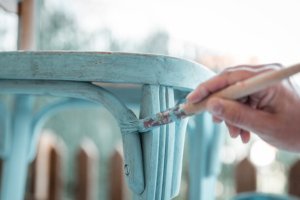Furniture constitutes a large part of the house, and maintaining it is an essential point. A simple painting or a colour change can uplift the overall appeal of the home. Painting the furniture allows you to refresh, update, and customise the belongings according to your style. This gives a new life and character to the furniture and to the room it is placed. You can change the theme of the room and customise it to your taste. In this article, we will explore the types, application techniques, and advantages of painting your furniture.
See also: What are oil paints?
Furniture paint: Meaning
Furniture paint involves painting your furniture to alter its style or color. Some people refer to it as wood paint. To prevent rusting, a specific type of paint is used to coat the wood surfaces of the furniture. The main goal of furniture paint is to give your furniture a fresh look for your living space. The protective finish of the furniture paint also safeguards it against normal wear and tear.
Furniture paint: Types
Latex paint
Furniture paint can also be referred to as water-based paint, which utilises water as a medium and consists of pigments, binders, and additives. Its versatility allows it to be used not only on furniture but also on walls, ceilings, and various other surfaces. Latex paint, as it is commonly known, is characterised by its water-based composition, quick drying time, easy clean-up, low or no odour, and ability to provide a flexible finish.
Oil-based paint
Furniture paint utilising oil or petroleum as a base for pigments and binders is commonly referred to as alkyd paint. It is a time-honoured option due to its exceptional adhesion, durability, and the wide range of finishes it can achieve on various surfaces. The resulting finish is smooth and glossy while also being flexible, resistant to breaking, and long-lasting on the surface.
Chalk paint
Chalk paint is a decorative type of furniture paint that lends a unique matte, velvety finish to surfaces. It replaces the traditional glossy finish with a more subdued, matte look. It requires minimal preparation for the surface, has good coverage, dries quickly, and has various colours to offer. The biggest advantage of being involved in chalk paint is that no primer is needed to prepare.
Milk paint
Milk paint is a paint that has been in use for many centuries and is a type of furniture paint that is environment-friendly. The components of milk paint are all natural, such as milk protein, lime, and earth pigments. It has a unique appearance, which is the reason for its recent popularity. It is safe to use and does not contain any toxins. It gives the surface a unique finish, is durable, fades naturally, and provides versatile colour options.
Spray paint
Spray paint is a unique type of furniture paint that comes in an aerosol can. It is used for DIY projects and for big-scale painting projects, too. It is a liquid paint that dries quickly, and the surfaces get a versatile and smooth finish. It provides efficient coverage to the surfaces and is easy to apply.
Furniture paint: Uses
Replenishing old furniture
The primary use of furniture paint is to give new life to the old furniture. This refreshes, replenishes, uplifts, and elevates the whole vibe of the room. It also helps in restoring the old pieces to life, is cost-efficient and reduces wastage by painting the existing furniture.
Customised furniture
You can customise the old furniture you always wanted using furniture paint. In case you initially purchased a piece of ready-made furniture, now is the time to style according to your taste. You can match the colour of the furniture to your overall vibe of the room.
Keeping up with the trends
To keep up with the latest trends and styles, furniture paint is a useful tool. Furniture paint allows you to change the colour and style anytime you want. The designs and the colour keep evolving and to keep up with the modern design, furniture paint can be helpful.
Furniture paint: Application techniques
Preparing the surface for paint
Start by removing the old distorted paint, cleaning the surface thoroughly, and sanding it for a smooth finish. Clean the surface and remove any dust, dirt, or grease. Repair any holes, fill the gaps in the furniture and then sand it in the end to get an even finish.
Priming the surface
Primer enhances the adhesion of the surface, so find a suitable primer for the surface and start applying it. Furniture material will depend on the type of primer to be used. After applying the primer, sand the surface lightly to smooth out any uneven areas.
Painting the surface
You can paint the surface using rollers, brushes, or sprays. If you are using brushes, make sure to purchase high-quality brushes for even coverage. Foam rollers are recommended for furniture painting. Maintaining a distance from the furniture, start spraying on the surface to apply the paint.
Furniture paint: Advantages
Cost-effective
Furniture paint is a cost-effective technique that can do a makeover for your room. You can avoid purchasing new furniture by using furniture paint techniques which is a budget-friendly way to transform your furniture. This reuses your old furniture ensuring sustainability without spending extra.
Customisation
Furniture paint elevates the aesthetic appeal of the house and you can transform the furniture according to your taste. There are a variety of colours and themes available for customising your furniture. You can revamp the surface according to the overall theme of the house.
Durability
The furniture’s surface is prevented from external harm if furniture paint is applied to it. It acts as a protective coat for the surface. It shields from general wear and tear and other scratches. The sealed furniture paint can protect from factors like humidity, sunlight, and any temperature changes.
Versatile
Furniture paint is versatile as it is available in different varieties, tones, and styles of colours. You can create your colour by using your creativity and imagination. A wide range of colours allows you to select the best colour aligning with the theme of the décor of the home.
FAQs
How to achieve perfect furniture paint?
To achieve perfect furniture paint, clean and sand the surface correctly, choose the right paint for the furniture, apply thin coats, avoid over-applying, and protect the furniture by applying a sealant.
What is the difference between furniture paint and general paint?
Furniture paint is a specialised paint used for wooden surfaces. It has strong adhesion properties which makes it different from a general paint.
On what surfaces could furniture paint be applied?
Furniture paint can be applied to surfaces like wood, plastic, metal, and glass.
Is it compulsory to prime before painting?
Yes, it is highly recommended to use a primer before applying paint for strong adhesion.
How to protect furniture paint?
To protect furniture paint, you can apply a coat of sealant when the paint dries off completely.
Is there any technique to paint intricate surfaces?
You can use fine-tip brushes which are used to paint intricate and detailed surfaces.
Can veneer or laminate furniture be painted with furniture paint?
Yes, you can paint the veneer or laminate furniture with furniture paint.
| Got any questions or point of view on our article? We would love to hear from you. Write to our Editor-in-Chief Jhumur Ghosh at jhumur.ghosh1@housing.com |

Shimon Oberoi, an economics graduate from Rajdhani College, University of Delhi, strives to simplify the real estate world through her compelling and well-researched content. She has experience in domains like entertainment and economic concepts, among others. When not creating content, she enjoys watching movies, listening to music, and reading fictional books.












